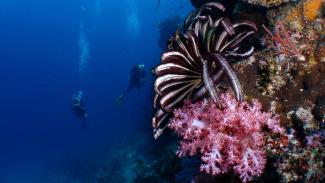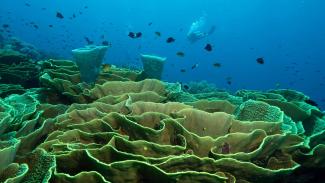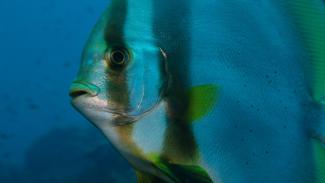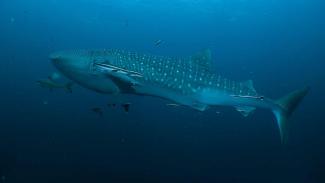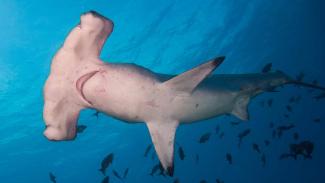Discover Thailand's most famous diving destination
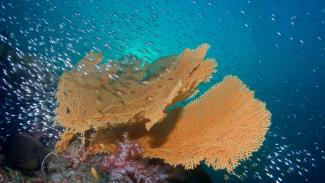
The Similan Islands in Thailand are the country's most famous diving destination, offering great visibility, stunning corals and prolific marine life.
Accessed primarily by liveaboard, the Similan Islands are in a strictly controlled marine park and are considered by many to be the crown jewels of Thailand’s diving. As well as the diving, they also offer picture perfect beaches and unspoilt habitats.
The islands lie around 100km north of Phuket and 40km off the mainland.
Further north, Ko Bon, Ko Tachai & Richelieu Rock bring more excellent diving opportunities and a great chance to come face to face with a Whale Shark.
Highlights
Best diving spots
Similan Islands
The name Similan is thought to originate from the Malay word Sembilan, meaning nine, as there are nine islands to dive and explore.
The east side has sloping coral reefs and bommies, with a wide variety of hard and soft corals - plus a host of interesting marine life. The most famous site here is probably East of Eden, which has a large coral bommie famed for its abundance and sheer diversity of life.
The western side of the Similan Islands is dramatically different, with enormous boulders creating one of the most unusual dive environments around. Caves, canyons, overhangs & swim-throughs, make these boulders a joy to swim through, while their sheer size will leave you feeling dwarfed. A very popular diving site on the west coast is Elephant Head Rock, so named because of its topside appearance. Many of the boulders here are covered in soft corals, while White-tip Reef Sharks are often seen cruising in the blue. The most northerly sites of the Similan Islands offer the best chance to see larger marine life, with Reef Sharks, Sting Rays, Leopard Sharks & even Manta Rays.
Ko Bon
The island of Ko Bon, just a little north from the Similan Island chain, has a large limestone ridge descending from its western side down to around 40m. The ridge receives very strong currents, which can reduce visibility, but these nutrient rich waters also attract Manta Rays. Fields of staghorn coral burst with smaller life, while sharks sometimes put in an appearance. There is also a deep pinnacle just off the ridge which, if conditions are good makes for an excellent dive for experienced divers.
Ko Tachai
Ko Tachai, a little further north again, is a fully submerged plateau starting at about 14m and gradually sloping away to 35m. On the south side, a series of boulders hide sleeping Leopard Sharks, while the north & west sides are home to fields of large Gorgonians sheltering an abundance of interesting marine life. Barracuda & Batfish hang in the blue, while Manta Rays & Whalesharks are also known to cruise by.
Richeleu Rock
The star of this area north of the Similan Islands is Richeleu Rock; a horse-shoe shaped rock that just breaks the surface. It has stunning corals along with a great variety and profusion of marine life, including many exotic species such as Ghost Pipefish and Seahorses. It also just happens to be one of the best places in Asia to meet a Whale Shark. These gentle giants are more frequently sighted here than in any other dive site in Thailand. Throw in the beautiful corals and diverse marine life and you have one of the best places to dive in Thailand.
Diving the Similan Islands is generally achieved by taking a liveaboard from Phuket or Khao Lak. Liveaboards are generally three to six days in duration depending on the itinerary. They make a fabulous introduction to liveaboard diving for the uninitiated.
When to dive
The best time to dive the Similan Islands is from November through to April. Outside these months, sea conditions make the islands difficult to reach. Sea temperatures are consistently between 28 and 30 degrees Celcius (83-87 degrees Fahrenheit), making diving very comfortable.
Getting there
Khao Lak is generally the jumping off point for diving the Similan & Surin Islands, however some longer liveaboards depart from Phuket.
Khao Lak is around 100km north of Phuket, which has a well connected international airport. Buses make daily trips to and from the area from Phuket and Phang Nga, however most resorts and liveaboards will happily arrange transfers.
Activities
Aside from diving, the Khao Lak area is rich in natural beauty and is on the edge of a national park, with nature trails to waterfalls & caves. There are also some nice beaches and also some beautiful Buddhist temples to visit.
Resort and liveaboard options
The Similan and Surin Islands are generally dived by liveaboard. They make a great introduction to liveaboard diving as itineraries tend to be shorter than other major liveaboard destinations, starting at just three days in duration.
It is also possible to stay in Khao Lak and make day diving trips to these islands, although boat journeys are fairly long.
Did you know?
The word Similan is thought to derive from the Malay word Sembilan, meaning nine. Therefore the name is thought to refer to the nine islands in the main Similan Island group. The traditional local dialect in Southern Thailand, called Yawi is closely associated with Malay.
Liveaboard diving in the Similan Islands
The Similan Islands make for an outstanding liveaboard diving destination. There is a wide choice of liveaboards operating out of either Khao Lak (Tap Lamu Pier) or Phuket, offering a range of itineraries.
Similan Islands liveaboards can make for a superb introduction to the world of liveaboard diving. Liveaboards in many other parts of the globe offer itineraries between 7 and 12 nights in duration. This is great for those accustomed to this style of diving. However, it is a long time to be on board if you do not yet know if liveaboard diving is for you.
Liveaboards in the Similans offer itineraries beginning from just 2 nights/3 days in duration. These shorter trips give you the full liveaboard experience, but serve as the ideal introduction. These shorter itineraries are also ideal for those who wish to explore Thailand’s many topside delights as part of their trip.
These shorter itineraries will sometimes focus on only the Similan islands or the Surin or northern Islands of Ko Bon, Ko Tachai and Richeleu Rock. Both offer great scuba diving, but be careful to pay attention to the itinerary offered if you have specific requirements.
For those looking for a longer Similan Islands liveaboard experience, itineraries are also available for longer periods, generally up to 6-nights in duration. These longer itineraries will tour both the Similan Islands and the islands of Ko Bon, Ko Tachai and Richeleu Rock.
Feeling really adventurous? A small number of liveaboard operators also offer extended itineraries heading farther north into the waters of Myanmar. Here, the Mergui Archipelago and Burma Banks offer more superb diving opportunities, with excellent diversity of marine experiences and environments, along with possible encounters of manta rays and other larger marine life.
We recommend the team at Liveaboard.com to find your perfect Similan liveaboard adventure!
Similan Island Hotels
There are no hotels or resorts on the Similan Islands, which are located inside a national park. However it is still possible to dive the Similan Islands from a resort-based dive center in Khao Lak.
The town of Khao Lak is a popular region around 60 minutes drive north of Phuket. In addition to scuba diving, it is popular for white sand beaches and wonderful nature in the surrounding area.
A number of dive centers offer day trips with two or three dives a day. Diving excursions can also be arranged to visit the more northerly islands of Ko Tachai, Ko Bon or Richeleu Rock.
The distance to the Similan Islands or the Surin Islands is quite long, so expect boat journey times of two to three hours and a full day trip. However this is a good option for those that do not wish to join a liveaboard.
When planning your diving holiday to Khao Lak, remember that the the season for the Similan Islands is from November through to the end of April. The islands are closed outside these months.
We recommend to use the excellent Dive Booker tool to find a dive center and even accommodation in Khao Lak.

You might also enjoy...
Southern Andaman
Thailand's southern Andaman sea boasts numerous beautiful islands & beaches, plus some great diving opportunities.
The southern Andaman region of Thailand is less developed than further north, offering a refreshingly relaxing alternative to the hustle & bustle of Phuket & even Ko Phi Phi.
Asia's endangered species
Tara North




